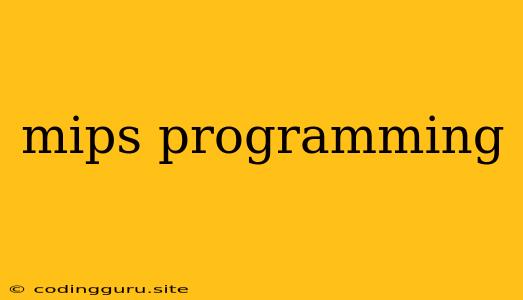Dive into the World of MIPS Programming: A Comprehensive Guide
MIPS, short for Microprocessor without Interlocked Pipeline Stages, is a Reduced Instruction Set Computer (RISC) architecture widely used in embedded systems, networking devices, and even as a teaching tool in computer architecture courses. If you're curious about the inner workings of computer systems or looking to explore the world of assembly language programming, MIPS provides an excellent starting point.
Why Choose MIPS Programming?
- Simplicity: MIPS architecture boasts a streamlined instruction set, making it easier to learn and understand compared to complex architectures like x86.
- Efficiency: MIPS is optimized for speed, thanks to its RISC design, making it ideal for tasks requiring quick execution.
- Accessibility: Numerous simulators and emulators are available, allowing you to experiment with MIPS programming without needing specialized hardware.
Getting Started with MIPS Programming
To begin your journey into MIPS programming, you'll need the following:
- A Text Editor: Any plain text editor will do.
- A MIPS Assembler: This tool converts your MIPS assembly code into machine-readable instructions. Popular options include SPIM, MARS, and QtSpim.
- A MIPS Simulator or Emulator: This software allows you to run your MIPS programs and observe their execution.
Essential MIPS Instructions
MIPS programming involves writing instructions that tell the processor what to do. Here are some fundamental instructions you'll encounter:
addiu $t0, $t1, 10: Adds 10 to the value in register$t1and stores the result in register$t0.lw $t0, 12($sp): Loads the value from memory location12bytes away from the stack pointer ($sp) into register$t0.sw $t0, 20($sp): Stores the value in register$t0to memory location20bytes away from the stack pointer ($sp).beq $t0, $t1, label: Branches to the labellabelif the values in registers$t0and$t1are equal.j label: Unconditional jump to the labellabel.
Writing Your First MIPS Program
Let's write a simple MIPS program that calculates the sum of two numbers:
.data
num1: .word 5
num2: .word 10
sum: .word 0
.text
.globl main
main:
lw $t0, num1
lw $t1, num2
add $t2, $t0, $t1
sw $t2, sum
li $v0, 10 # Exit program
syscall
Explanation:
-
.datadefines data segment:num1: Stores the first number (5).num2: Stores the second number (10).sum: Stores the calculated sum (initialized to 0).
-
.textdefines the text segment:.globl main: Declares themainfunction as the entry point.
-
mainfunction:lw $t0, num1: Loads the value fromnum1into register$t0.lw $t1, num2: Loads the value fromnum2into register$t1.add $t2, $t0, $t1: Adds the values in registers$t0and$t1and stores the result in register$t2.sw $t2, sum: Stores the result in register$t2into the memory locationsum.li $v0, 10: Sets system call code for program exit.syscall: Executes the system call to exit the program.
Debugging Your MIPS Programs
When your code doesn't work as expected, debugging is crucial. Simulators and emulators come equipped with debugging features such as breakpoints, single-stepping, and register inspection. These tools allow you to examine the state of your program at specific points, identify errors, and refine your code.
Advanced MIPS Concepts
As you delve deeper into MIPS programming, you'll encounter more sophisticated concepts:
- Memory Allocation: Understanding how to manage memory addresses, allocate memory for variables, and manipulate the stack.
- Procedures and Function Calls: Writing reusable functions and passing arguments using the stack.
- Interrupts and Exception Handling: Handling unexpected events or errors during program execution.
- Input/Output Operations: Interacting with external devices such as the keyboard, screen, and disk drives.
MIPS Programming Applications
The versatility of MIPS architecture extends its use across various domains:
- Embedded Systems: From controlling appliances to managing industrial processes, MIPS-based processors are embedded in countless devices.
- Networking Devices: Routers, switches, and other network equipment often rely on MIPS processors for efficient data handling.
- Academic Research: Universities use MIPS as a pedagogical tool to teach computer architecture and assembly language programming.
Conclusion
Mastering MIPS programming can be a rewarding journey. By understanding the fundamentals of this powerful architecture, you'll gain a deeper appreciation for how computers operate at their core. Whether you're interested in embedded systems, networking, or simply want to broaden your programming knowledge, MIPS offers a unique and valuable learning experience.
